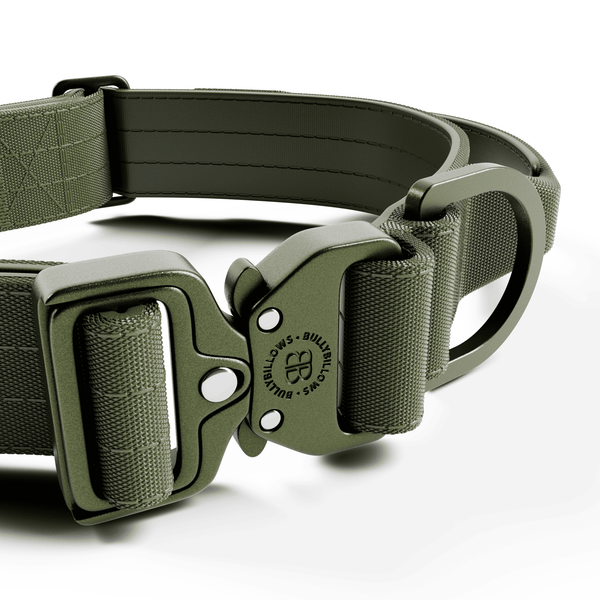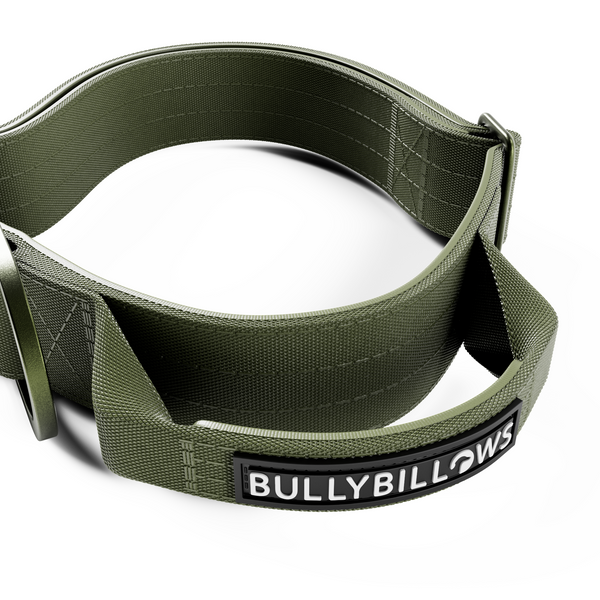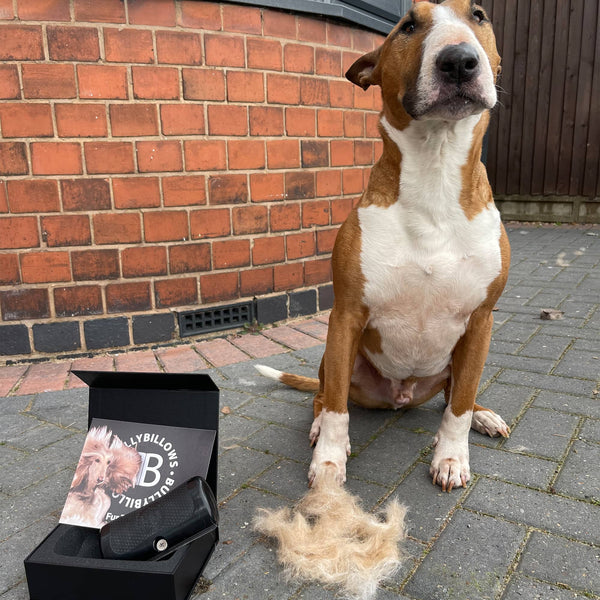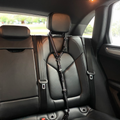As a dog owner (or soon-to-be dog owner!), you're likely aware of how essential it is to find the right gear for your furry companion. And, when your dog has access to a high-quality dog harness, it will be sure to provide comfort and enhance safety and control for you and your pup.
But with so many different types, styles, and features, we wouldn’t blame you for feeling a little lost when deciding which is best! Plus, the answer is it’ll depend on your dog. So, we’re here to help!
In this guide, we'll walk you through everything you need to know about harnesses to ensure you choose the perfect type to suit your dog's needs. So, whether you're wondering how to measure your furry friend correctly or want to better understand the differences between the various harness types, we've covered it all. Rest assured, we've left no stone unturned in our mission to provide you with all the necessary information!
Read on to discover the ultimate guide to dog harnesses…

What is a dog harness?
A dog harness can be defined as a piece of standard equipment that provides enhanced guidance and control to you and your pup. They’re also known for giving a sense of comfort to dogs during walks, as they reduce the tension around the neck, especially if your dog’s a puller!
There are many different dog harness types, materials, styles and designs to choose from (which we’ll go into more detail about later). However, generally speaking, a dog harness will fit around your dog's torso area using adjustable straps, ensuring a perfect fit.
In addition to the above, various types of dog harnesses are purpose-built, with each option offering its own benefits. This can include harnesses specifically designed for training, light strolling or high-activity adventures.
Depending on the harness's design, it may contain different characteristics and features. For example, suppose you were to purchase a dog harness designed for training. In that case, it may include additional features, such as a handle towards the top of the harness (the back of your dog), to provide the trainer with more control.
What is the purpose of a dog harness?
A harness's most important job is providing your dog with comfort and security without restricting movement.
A quality harness should also distribute weight evenly across the body and work to minimise pressure on the neck and throat area, which can sometimes lead to discomfort or injury. Another essential purpose of a dog harness is to give you a better level of control.
How far back in time can we trace the use of dog harnesses?
Honestly? No one really knows! Dog harnesses trace back thousands of years, with their origin unclear. Evidence suggests that dog harnesses have been used for centuries by the ancient Greeks, Romans and even the Egyptians. What we do know, however, is that roughly 2000 years ago, neck and girth harnesses became popular in Europe.
Harnesses were then used by animals (not just dogs!) drafted for battle by many ancient cultures and civilisations. However, for dogs specifically, harnesses were usually reserved for ‘working’ dogs.
Working dogs, such as sledge dogs and hunting dogs, were often equipped with harnesses instead of collars, as harnesses distributed the weight of a load or equipment across the dog's chest and back rather than having the pressure directed on their neck.
This was very important because the pressure of pulling heavy weights could be uncomfortable and even harmful to a dog's neck. Using a harness, the dog could pull the weight more comfortably and efficiently without the added strain.

Browse our TRI-Harnesses® collection today.
Which materials are used to create dog harnesses?
The answer to this question is many, but the most common material variations are leather, nylon, neoprene and polyester. Let’s take a look at each one briefly:
Nylon
Nylon is a synthetic material, and it’s great for dog harnesses. It’s lightweight, breathable, ultra-durable, water-resistant and incredibly versatile. So, you’ll be able to find nylon dog harnesses in a broad range of sizes, colours and types, with pattern options also common, too.
Moreover, nylon is incredibly easy to clean down, especially if your dog loves exploring muddy puddles! It’s also a material that’ll provide a very comfortable fit for your dog if you measure correctly.
Leather
Leather dog products, such as harnesses, collars and leashes, are known for their durability and stylish appearance.
But just like all materials, the leather type will dictate the overall quality of the gear. So, for example, you’ll find dog harnesses made from split-grain, top-grain, or full-grain leather, with the latter being of the highest quality.
Leather dog products have a divided opinion, as an increasing number of people in the UK are starting to step away from animal products. Plus, leather tends to be quite expensive, requiring more maintenance than any other material option to ensure longevity. So, maybe there are better options for a bouncy, full-of-life dog!
Polyester
Polyester is tricky, as its properties can vary depending on the type. However, it is a synthetic material you’ll commonly see used to produce dog harnesses. Polyester generally makes good quality dog harnesses that can keep up with active natures, and it’s also relatively easy to clean.
It’s worth noting that not all polyester is made equally. Great quality polyester will provide durability, comfort, and breathability for your furry friend, so watch for signs that it has been manufactured correctly. For example, if you spot premature fraying, the material feels scratchy, or it fits your dog stiffly (even though you measured your dog perfectly!), it’s probably a bad-quality dog harness.
Neoprene
Neoprene is a synthetic rubber that is interestingly used to create reliable wetsuits for us humans.
Neoprene serves as the go-to lining material for quality dog harnesses. It’s renowned for its quick-drying and odour-resistant properties, as well as being ultra-soft and comfortable for dogs.
Additionally, neoprene is also incredibly durable and resistant to wear and tear and UV rays - making it ideal for dogs who love to explore the outdoors.
For example, here at BullyBillows, we design all of our harness collections with comfort and quality in mind. So, we’ve taken it a step further than any other company and incorporated neoprene or a neoprene and foam combination in all of our products, to ensure that we offer the most comfortable and effective dog gear out there.

(Photo courtesy of @rita.the.rottie) Browse our Step In Harness collection today.
What are the main benefits of a dog harness, and how does it work?
In reality, a dog harness has many purposes: comfort, control, guidance and enhanced safety and support. We’ll explain the key benefits below:
- Enhanced comfort - harnesses are generally much more comfortable for pups because they won’t feel an unbalanced amount of pressure in one area.
- Improved control - in situations where you need to guide your dog, it’ll be easier to do so as you’ll have a better ability to manage your dog's movements and reactions.
- Better guidance for you - ever been yanked over by your dog unexpectedly? If your dog is powerful, you may feel a little out of control with a collar. This is purely based on preference, but a harness will undoubtedly shift power back to you should you need it, as you’ll have more control over a larger portion of your dog’s body. After all, they’re designed to discourage your dog from excessively pulling!
- Safety - a quality harness will prevent injury to your dog’s neck because it can evenly distribute weight across the body. Plus, there’s much less chance of a dog slipping out of a harness than there is with a collar!
- Support - they’re convenient for training, especially if you have a puppy. Harnesses provide a more secure and stable attachment than collars, which some pups will require when learning to go for walks on a leash.
- Variety - there are many different types, styles and sizes of dog harness options to choose from, each with its own purpose. This makes it easier to find the right one for your unique pup.
- Added features - harnesses can feature a wide variety of valuable features, such as additional padding, for enhanced comfort. Or, another example would be the inclusion of a reinforced handle for more control over situations that require you to think fast.
In terms of how it works, a dog harness will quite literally harness your dog's pulling power to allow for more control to be given to you without their movement being compromised. In addition, it’ll take the pressure away from just the neck and distribute it evenly across the shoulders, chest, back and general torso area.
It’s worth mentioning that for a dog harness to be practical, it must fit correctly. If not, your dog may be able to wiggle itself out of the harness, or in some cases, weight distribution may not be as effective. But fear not! We’ll take you through how to accurately measure your dog for a harness later in this article. More reason to stick around!

(Photo courtesy of @_gsdbear) Browse our Active Light Harness collection today.
Factors to consider when purchasing a dog harness
Below, we’ve provided every factor you should consider before purchasing a harness for your pup.
- Harness type - if it were one-size-fits-all, there wouldn’t be so many harness variations. Look at the options available, and determine which harness you and your dog would benefit from the most. Sometimes this can be a trial-and-error scenario, so if you find that a specific harness type isn’t working for you - try another!
- Harness fit - if the harness doesn’t fit correctly, you may find yourself in one (or all) of the following situations: your dog will remove the harness, you’ll lose control of the harness, or it’ll generally be ineffective and uncomfortable for your dog to wear. Ensure you measure correctly, and check for any signs of it not being a perfect fit.
- Harness purpose - as we mentioned earlier, certain harnesses are available that are tailored to support specific situations. For example, we’re not entirely sure whether a senior dog would benefit from a harness designed for training, and instead, a simple harness to support light strolls may be more than enough. So, always look out for what the harness is made to do.
- Harness material - harnesses need to be strong. So, the materials need to be reliable and known for their durability. Always check what the harness is made of before committing to a purchase. Effective harness materials are nylon and neoprene, renowned for their strength and ability to withstand wear and tear with rigorous use.
- Comfort - a well-fitting harness will provide great comfort to your pup. But did you know that there are options that offer enhanced features, ideal for dogs that need a little more than usual? For example, you’ll be able to find harnesses made with added padding around specific areas.
- Special requirements - does your dog have a girthier neck than general measurements allow for? Or they may have sensitive skin. Whatever you require, rest assured that there’s a harness that accommodates this (at BullyBillows there is, anyway). For example, choose an entirely flexible option if your dog has conflicting measurements according to harness size guidelines.
- Safety features - are you and your dog fans of a nice late-night stroll? You may benefit from additional safety features like reflective materials to ensure your dog is visible in low-light conditions.
- Convenience - no one wants an overcomplicated harness. Find the right option that works for your dog that doesn’t require you to buckle, velcro and zip the harness in a zillion different ways!
- Cost - look for a harness that’ll provide the most value for money. That’s why investing in a decent, well-made dog harness is so essential, as it’ll be built to last. Consider the quality, the manufacturer and any added features in the design.

(Photo courtesy of @chelsea_amstaff_) Browse our Slip On Harness collection today.
Are harnesses suitable for smaller dogs?
Yes, dog harnesses are more than suitable for smaller dogs. In fact, they’re favoured by many professionals (e.g. veterinary practitioners and dog trainers) as the safer option for smaller companions. We’ll explain why below.
Generally speaking, smaller dog breeds have more sensitive tracheas, or in some cases, they can be born with inherited trachea problems. This is also commonly referred to as their windpipes.
We see this commonly in miniature breeds, as they are more susceptible to this defect (e.g. Chihuahuas, Yorkshire Terriers and Pomeranians). So, this means that the cartilage in the trachea is at a predisposition to be weaker, which (in some cases) can lead to a collapsed trachea if too much pressure and strain is placed on the neck area.
It’s worth noting that it’s perfectly fine for smaller breeds to wear collars to hold I.D. tags, but it’s best to transition them into wearing a harness for walking. And larger dogs are not immune to this, as it can happen to all dog breeds - we only see it more frequently with smaller dogs due to the delicate nature of their windpipes.
To summarise the above, dog harnesses are the best option for smaller dogs. This is because they disperse that pressure across the body, creating a safer balance than having the strain centred around the neck area.
Dog harnesses vs collars - which is better?
Both are great options, and dogs should have access to both. However, each option has its advantages and weaknesses, depending on the scenario and your combined requirements. We’ll explain below.
Collars are a superb option for those requiring more guidance over their stronger dogs, as it’ll take much less physical strain for you to gain control over your dog. Some collars are also built with reinforced handle placements, usually towards the top of the collar, to provide a better grip in case of an emergency situation.
Collars can also be kept on permanently, whereas keeping a dog in a harness outside walkies is uncommon. They also tend to hold essential information (I.D. tags) about how to contact you if your dog were ever to become an escape artist, which is particularly important, even if it’s just for peace of mind.

Browse BullyBillows collars today.
On the other hand, a harness is (generally) a safer option when your dog is active. As we’ve mentioned throughout this article, minimising the pressure on the neck is always beneficial, and a harness allows you to do that. In addition, it’ll evenly distribute the weight around your dog’s torso, keeping your pup comfortable and happy.
Plus, they tend to be seen as the more secure option, as it’s typically harder for a dog to remove the harness when compared to a collar. Your dog will have more power and control over their movements, but you’ll still be able to navigate the situation with proper guidance over the harness. Plus, similar to collars, harnesses can also be constructed with the addition of a security handle in the event of a scenario where you need to act quickly.
So, both are great options, but a harness is typically considered the safer option for dogs. Both are important, and each option has its own benefits.
How to measure a dog for a harness
We understand that there’s a lot of conflicting information out there about how to measure a dog for a harness. So, let us bring a little clarity to the situation.
See below for a step-by-step guide on how to precisely (and easily) size your dog up for a harness.
- Start by making sure you’ve got a measuring tape. No, not your iPhone measurement app - a real one!
- Focus on your pup’s girth. Then, wrap the measuring tape around the widest section of their ribcage.
- Then you’ll want to measure your dog’s neck. Measure around the base of your dog’s neck (where a collar would go). Ensure your final measurements are not too restrictive but secure.
- Cross-reference your dog’s measurements to the size guide provided. This is important, as sizes can vary depending on the manufacturer. If uncertain, try to go for a harness that offers adjustable straps.
- Once you’ve got the harness, you only need to get your dog to try it on for size. A rule of thumb is to ensure you can fit at least two fingers between the harness and your dog's body. If you can’t, it’s too tight. If you can fit more, it’s likely not tight enough.
- Lastly, take a step back and monitor your dog. More specifically, (assuming your dog has worn harnesses before) how they behave. Are they walking awkwardly? Are they refusing to walk? Or, later down the line, have they developed bald patches around where the harness sits? These are all telltale signs the harness isn’t the right fit for your pup.

(Photo courtesy of @ronniethabully) Browse our MINI TRI-Harness® collection today.
The most common types of dog harnesses
Various types of dog harnesses are available, so we’ll look at the most common types below.
Vest harnesses
Commonly referred to as the “perfect fit dog harness”, a vest harness offers more of a full-coverage fit when compared to other harnesses. As you may have guessed by the name, they are generally compared to a padded vest-like structure - as they’ll cover your dog’s chest and back area.
Vest harnesses can vary regarding strap and buckle structure, along with where the leash clip attachment is positioned, but it’s usually on the back of the harness. Most dog harnesses have the leash clip on the back unless specified otherwise. Vest harness straps or buckles are usually secured on either side of your dog’s torso.
Although not always the case, vest harnesses tend to be adjustable around the torso area but not across the neck. Added features, such as reflective materials and additional padding, can be included in the design of a vest harness.
Vest harnesses are a great option if your dog isn’t an excessive puller. These types of harnesses offer great control, but they’re designed to focus on weight distribution and comfort above all else!
Dual-clip harnesses
Dual-clip harnesses can be featured on any type of harness; however, it’s most commonly seen on a vest and no pull harnesses.
Also commonly referred to as a multi-clip harness, all this means is that the harness has a leash attachment at both the front and back. This is great if you have a reactive dog, which is why it’s frequently used by professional dog trainers.
A dual-clip harness means you’ll be able to use the back clip for normal walking patterns. However, suppose you were to find yourself in a position where your dog has become particularly reactive (e.g. showing territorial signs of aggression, jumping or pulling). In that case, the front clip will give you more control over your pup’s movements.
So, if you have a particularly laid-back dog on your hands, a dual clip may not be necessary!
Step in harnesses
Step in harnesses and slip on harnesses are often mistaken for the same thing, but they are not.
A step in harness is exactly what it says on the tin. They are specially designed to be put on by stepping into it. This is done by placing the harness flat on the ground, letting your dog step into the harness, and then lifting it up and around their body to strap them in. These types of harnesses may also feature velcro, as opposed to (or as well as) buckles and strap attachments.
A step in harness is a great option for almost all dogs, especially for the more nervous pups. This is because you won’t need to put the harness over their heads to get it on, so it’s a little less daunting for our more timid friends.
Slip on harnesses
Slip on harnesses simply means they are designed to slide over your dog's head and adjust across the shoulder and chest area. So, as you can see - they are the polar opposite of a step in harness!
Slip on harnesses are seen as a great option for the majority of dogs, no matter the breed. They tend to be lightweight, sturdy and secure, and easy to put on and remove from your dog.
Slip on harnesses resembles a combination of a webbed harness and a vest harness. A hybrid, if you will. They are usually made from soft, mesh-like material but with slightly more of a structure, similar to what we see with vest harnesses.
No pull dog harnesses
To be fair to your dog, pulling is a literal instinct that we all have if we feel a pulling sensation. The formal name for this is opposition pulling.
Most dogs will have a touch of this, but not all. To see whether your dog has a strong opposition-pulling reflex, gently pull your dog towards you. If you can feel them pulling away, even if it’s ever so slightly, that’s an opposition-pulling reflex right there.
It’s an automatic reaction for most dogs, but if it’s extreme and you struggle to maintain control on walks, you’ll likely benefit from a no pull dog harness.
A no pull dog harness will commonly feature a front and back clip for the leash, which may also be accompanied by a reinforced handle located on the back of the harness. This is for you to pull back your dog when all else fails. These types of harnesses can be made as a vest or webbed harnesses.
Most people assume no pull harnesses are made for bigger, stronger dogs - but this isn’t always the case.
Smaller dogs can have surprisingly a lot of pulling power, which is why you’ll undoubtedly be able to find sizes to suit small (even miniature) dog breeds. So, if your little dog tends to pull, our MINI TRI-Harness® collection is the perfect solution.
Tips for getting your dog used to a harness
If your pup has become accustomed to wearing a collar, a harness will probably feel a little foreign at first. However, try not to worry about this too much, as you’ll be surprised by how quickly your pup will adjust to the feel of it.
Here are some top tips for getting your dog used to the idea of wearing a harness:
- This one may sound odd, but expose your dog to the harness! Leave the harness around the house in areas that your dog can see. That way, they’ll become familiar with what it looks like. Let them hear what the buckles or straps sound like when secured. Let them have a sniff. The usual stuff.
- Slip the harness over their head (if you’ve invested in a type of harness that requires this to put it on). Don’t clip them in just yet; instead, simply start to get them used to this action. Once they’re happy with that, move to strap them every now and then, just to see how they respond.
- Let them wear it around the house. It may take a little patience before they’re ready to wear it out, so this will help them to grow accustomed to how a dog harness feels and what it’s like to wear one.
- Always remember to reward good behaviour!
- Try a short walk wearing the harness for the first time.
- Once you’re confident that your dog feels comfortable in their new harness, continue your normal walking routine with the harness.
Discover top-quality dog harnesses at BullyBillows
Here at BullyBillows, we’ve carefully curated our range of dog harnesses to cater to all dog breeds, no matter their size or preference.
And, rest assured our collections are tried and tested. When we visualise a product, we put it and the material to the test for several weeks or months.
Then, we enlist the help of many furry friends, allowing them to try it out within a broad range of environments to ensure that our product meets the high-quality standards that we hold ourselves to! So, if it’s available with us - it’s of unbeatable quality.
So, if you want to know more about what you can find here with us, see below for more information on what each distinct collection can offer your pup.
BullyBillows Comfort Harness collection
Looking for a comfortable and flexible harness that caters to all breeds, no matter how big or small? Look no further than our uniquely designed BullyBillows Comfort Harness range. Exceptionally soft and comfortable, without restricting any natural body movement.
This collection emphasises providing dogs with unparalleled comfort, with adjustable straps and extra neoprene padding in the right places, ensuring a perfect fit for your furry friend - even as they grow or put on weight.
The harness has been designed with soft and breathable padding that will snugly fit around your dog's waist, providing comfort and security without the risk of any rubbing or burns. Ideal for pups with sensitive fur or skin.
Good to know - this collection is trademarked and copyrighted with the design rights number 6189796 for guaranteed quality and uniqueness.

Browse our Comfort Harness range today.
BullyBillows Slip On Harness collection
For our Slip On Harness collection, we’ve chosen the highest-quality materials, including foam for exceptional comfort, neoprene for fast-drying and comfort qualities, and 3M reflective strips - perfect for nighttime exploring.
Our innovative Y-shaped design ensures complete freedom of movement for your dog's shoulders and body, without constraints on their breathing.
This range features stainless-steel D-Loops, built to last and will not rust over time, ensuring long-lasting durability for your pup. In addition, our RR harness is designed to be both hygienic and comfortable, making it a perfect option for dogs with sensitive skin or allergies.

BullyBillows Active Light Harness collection
Next, we have our fantastic BullyBillows Active Light Harness collection. This range is also made using durable and highly reflective 3M material, which is complemented by a robust, water-resistant fabric.
This strong, yet surprisingly lightweight everyday harness also features soft and breathable neoprene padding to further ensure comfort. It’ll fit like a glove, making it perfect for any activity or level of exercise. Plus, it comes with an emergency grab handle that gives you more control over your furry friend.
Our unique design ensures the harness is exceptionally comfortable and ultra-soft, without restricting natural body movement like other brands. It is designed with all breeds in mind, so rest assured there’s the perfect harness for your dog in this collection.
Good to know - this collection has a different fit and size guide than other collections.

Browse our Active Light Harness collection today.
BullyBillows TRI-Harnesses® collection
You can’t go wrong with our TRI-Harnesses® collection.
This collection of high-quality harnesses is designed to provide exceptional comfort and durability, with three key points of contact for a lead - two on the back and one on the front.
The TRI-Harnesses® collection ensures that you have total control over your dog whilst also avoiding any sensitive areas prone to rubbing. In addition, this unique design will allow you and your pup to have more comfortable and enjoyable adventures.
What’s more, if your dog is an excessive puller, you’ll already know how difficult some walking experiences can be. But with this harness, you can reduce the risk of injury and control even the most challenging behaviours. This harness design is truly a game-changer.
Good to know - this design is trademarked and copyrighted! Design Rights Number - 6189802.

Browse our TRI-Harnesses® collection today.
BullyBillows MINI TRI-Harness® collection
Shout out to the smaller breeds! This one’s for you. Introducing our BullyBillows MINI TRI-Harness® collection.
This collection offers all the same benefits as the TRI-Harness® range but is specially designed to fit smaller dog breeds and puppies perfectly.
If there’s one thing for sure, it’s that this collection will provide exceptional comfort, durability and long-lasting quality. Also, this collection has been designed to avoid any sensitive areas (such as the underarms) which may be prone to rubbing without compromising your level of control.
Good to know - this design is unique to BullyBillows! (Tademark & Copyrighted Design Rights Number: 6189802).

Browse our MINI TRI-Harness® collection today.
BullyBillows Step In Harness collection
If you've been looking for a harness that prioritises your dog's comfort and freedom of movement without compromising quality, look no further. Introducing our fantastic Step In Harness collection!
The Step In Harness collection is bursting with the most lightweight and cosy dog harness options, specially designed for smaller and medium-sized pups. Expertly crafted from breathable air mesh, velvet lining and reflective piping, this harness is effortless to use and comfortable for your furry friend during any level of activity.
In addition, the collection features adjustable straps and 3M reflective materials for safe and visible walks while adapting to your dog's unique body shape!

Browse our Step In Harness collection today.
BullyBillows: the home of premium quality dog gear
We hope you’ve found our dog harness buying guide interesting but above all else, helpful!
Remember, at BullyBillows, we offer much more than our wide range of comfortable and durable harnesses for dogs of all shapes and sizes. From quality collars and accessories to treat pouches, I.D. tags and everything in between - browse the rest of our website today for more incredible dog gear.
Shop quality dog harnesses at BullyBillows today
For more helpful insights and information, check out the rest of our blog…
Follow us on Facebook, Instagram and TikTok!
Top 10 Small Dog Breeds | Top Three Reasons Why Your Dog Licks You | Tips to Train Your Dog Not to Bark at Strangers


































































